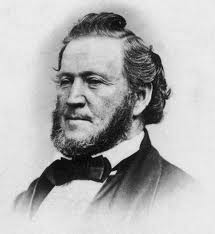READ: What Groups Came West?
| Site: | Mountain Heights Academy OER |
| Course: | English US History 8 Q3 |
| Book: | READ: What Groups Came West? |
| Printed by: | Guest user |
| Date: | Wednesday, 23 July 2025, 7:11 PM |
Mormons
Primary Source
The April sun at daybreak cast long, lonesome shadows across William Grant’s hometown village, Willenhall, Staffordshire, in England. A 28-year-old convert of sixteen years, he clutched the cornet that had won him prominence in the brass band, checked his pockets for hard-earned savings, and turned toward Liverpool and the ship that would take him, his wife, and their three children to Zion.
“I took one long look Back, … Thousands of Circumstances Crowding my mind of things in the past,” he wrote, “but they were soon forgotton in thoughts for the great future. Some 9000 Miles of Travel was here before us.”
William would live out his life in American Fork, Utah, a bandleader, choirmaster, music store owner, and part-time farmer. When he arrived in 1866, he owned only the belongings he had packed into a small cart in Willenhall. “Economy was the motto,” he remembered. “We denied Ourselves all Luxury and barely took the Necessaries of life.” 1 They had not even been able to afford cooking utensils for the ocean voyage. Like thousands and tens of thousands of Latter-day Saints who repeated the process between 1840 and the end of the century, William Grant sacrificed property, friends, family, and familiar surroundings because of his faith in the principle of the gathering.
Why did they come?
How did the Mormons end up in Utah?

Joseph Smith
The Church of Jesus Christ of Latter-day Saints (also known as the Mormon or LDS church) was started by Joseph Smith in 1830 in New York. Later, members of this church gathered in Nauvoo, Illinois.
Some people disliked Mormon beliefs and practices and persecuted members of this church. After a mob murdered Joseph Smith in 1844, his followers started to think about moving somewhere where they could live peacefully. Enemies were still attacking Mormons in different ways. Because of this persecution, in the cold of February 1846 the Mormons began to leave Nauvoo. They journeyed to Winter Quarters, Nebraska, and set up a temporary community.
The Mormon Battalion
The Mormon Battalion

James K. Polk
Because they had left behind their lands, buildings, and many possessions, the Mormons asked the federal government for financial help. The U.S. had declared war on Mexico in May 1846, so President James K. Polk agreed to enlist a battalion of Mormon men, who would receive pay for their service.

The Mormon Battalion at the Gila River in Arizona, a painting by George Ottinger (1833-1917).
Around 500 volunteers enlisted and began a grueling march to San Diego (33 women and 51 children started out with them). During 1846-47, these men blazed a wagon route across the Southwest, but they never fought in the war.
Their pay and their later explorations helped the Mormons become established in Utah.
Brigham Young

In April 1847 the first group of Mormon settlers left and headed west along the California Trail. Brigham Young led a group of two children, three women, and 143 men. They traveled on horseback or in oxen-pulled wagons for three months; then, on July 22, the first men entered the Salt Lake Valley. Brigham Young himself arrived on July 24, 1847.
Farmers and Missionaries

In 1842, a slightly larger group of 100 pioneers made the 2,000-mile journey to Oregon. The next year, however, the number of emigrants skyrocketed to 1,000. The sudden increase was a product of a severe depression in the Midwest combined with a flood of propaganda from fur traders, missionaries, and government officials extolling the virtues of the land. Farmers dissatisfied with their prospects in Ohio, Illinois, Kentucky, andTennessee, hoped to find better lives in the supposed paradise of Oregon.
On this day in 1843, some 1,000 men, women, and children climbed aboard their wagons and steered their horses west out of the small town of Elm Grove, Missouri. The train comprised more than 100 wagons with a herd of 5,000 oxen and cattle trailing behind. Dr. Elijah White, a Presbyterian missionary who had made the trip the year before, served as guide.
Gold Rush- Miners
This short clip shows the California Gold Rush. It brought people from all over the world!!
Poor immigrants
Oklahoma Land Rush
The Oklahoma Land Rush of 1889 was the first land run into the Unassigned Lands and included all or part of the 2005 modern day Canadian, Cleveland, Kingfisher, Logan, Oklahoma, and Payne counties of the U.S. state of Oklahoma. When the cannons went off in the morning you had to race to claim a plot of land.